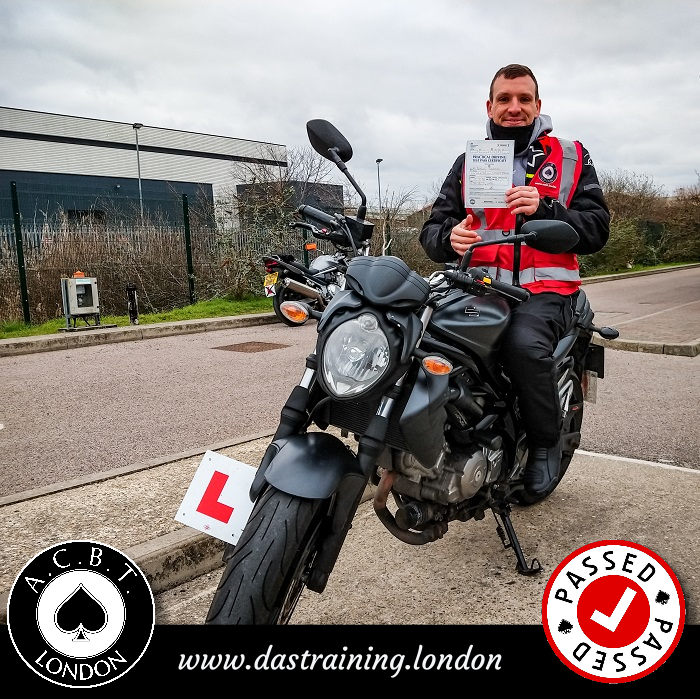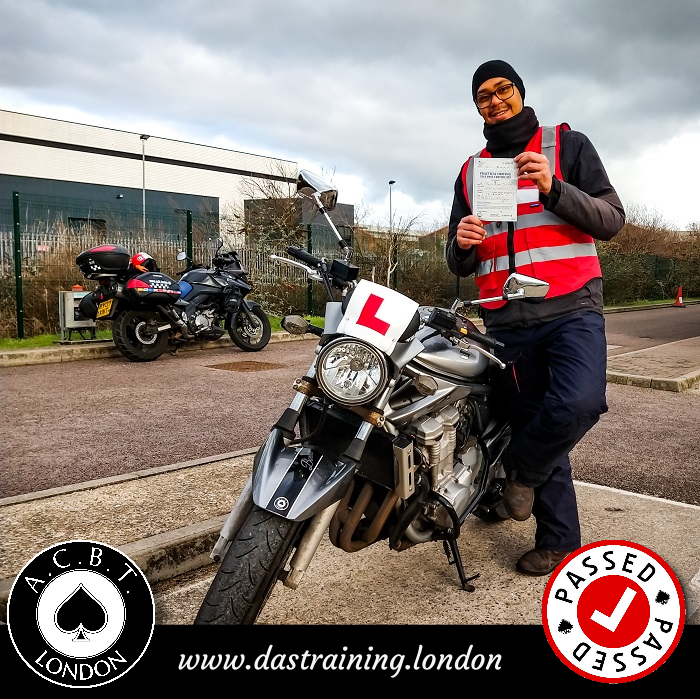Pass the motorbike test!
- ACBT London

- Mar 18, 2023
- 8 min read
Updated: Apr 7
So you want to pass your motorbike test.
How the motorcycle test process works in the UK. If you are interested in training to pass your test simply complete this form and we will get in touch to discuss your individual training scheme. Our courses are not run with a “one size fits all” approach. As everyone is different, our training courses are designed around your specific needs. Completing the form will give us an initial understanding of what those needs are. Alternatively call us on 0208 331 1103 or email us.

We are often asked to explain how to pass the motorcycle test and how the test process works as it can seem confusing.
We have already published an article explaining how to start motorcycle training and another discussing the different licences available to you. This article also has links so you can book your theory test. These links also explain in detail the difference between Progressive Access Scheme (PAS) and Direct Access Scheme (DAS).
The motorcycle test is essentially composed of three sections. The theory test (including hazard awareness), Module 1 and Module 2. In order to take your test you need to have first completed your CBT and your theory test. If you haven’t yet booked your theory test you can do so here. If you haven’t yet taken your CBT you can book it here.
Why is it so flipping complicated?
The purpose of the Module 1 test is for you to demonstrate to the DVSA (Driver and Vehicle Standards Agency) examiner that you have reached a sufficient standard of control of the motorcycle to be safely taken on the road for your Module 2 (practical) test. Similar to CBT, you first need to demonstrate you have good control before going on the road. If you fail your Module 1 test you will not be permitted to take your Module 2 test.
Once you have passed Module 1 you will receive a pass certificate for this element and it will remain current as long as your theory test certificate has left to run. In other words, it will expire on the same date as your theory test. This is important as it can affect the timing of your training and test dates so make sure your theory test certificate has plenty of time left to allow you to complete the test process.
We will discuss all this with you in detail as you make your booking so don’t worry. We will guide you through the complete test process, whether you take the Progressive Access route or the Direct Access Route. Again, don’t worry about the terminology, we will explain and clarify everything.
The Module 1 test
Training for the test is carried out by our DAS qualified instructor at our training area. You will be using a bike commensurate to the requirements of your test. In other words, if you are following the Progressive Access route and will be going for an A1 licence you will use one of our 125cc motorcycles. If for the A2 licence one of our 35Kw compliant motorcycles and if the A (unrestricted) licence or upgrading from A2, you will be using one of our full power motorcycles.
The test itself will be with a DVSA examiner at the DVSA test centre. Most of the time we use the test centre at Erith. See the image below. It is close to our training ground (only 8 miles) which allows us to maximise your training time. Our training area is large enough for us to create a simulation of the test centre. We can lay out each element to the exact distances as on test. Our training ground is also large enough to allow you to reach the necessary speeds as some exercises have a minimum speed requirement.
Your training will be designed to give you the best possible chance of success and we will practice each of the elements sufficiently for you to be fully confident to pass the test. We will give you all the information, tips and hints you need to be fully prepared. Failing to plan is planning to fail so we will ensure we leave nothing to chance.
The DVSA test centre at Erith.

The image is a bird’s eye view of the test area. It is a huge expanse of high quality tarmac in excellent condition. The different colour dots represent the arrangements of cones used to guide you through the test. We have used the same colours as at the test centre. You can view and download diagrams of the test centre from the .gov website here. By the time of your test you will have full understanding of this layout. You will see there are two speed measuring device locations and two locations for the u-turn. You will only have to use one on test day. The DVSA regularly change the area in a right hand or left hand steering arrangement. They do not publish which it will be on your test.
Key to the image:
A: Motorcycle parking bays
B: Entrance gate to the test area
C: Location of toilets and waiting area for car tests
1: Start of test
2: Manual Handling bays
3: Slalom/figure eight area
4: Slow control ride area
5: U-turn exercise area
6: Location of speed measuring device
7: Avoidance exercise cones
8: Outer circuit area
The test elements
There are a series of set exercises you will be asked to perform. Consult the site plan above with the information below. A manual handling exercise, three slow control exercises and three high speed exercises. Touching or knocking over any of the cones will result in failing the test. Our Youtube channel has videos of each exercise and we have included the links to each one here. Whilst there why not subscribe to the channel?
At the start of the test you will be asked to ride in through the access gate and wait while the gate is closed behind you. There will only be one motorcycle on the area at any time, the video is here.
1: Manual handling exercise: In this element you will be asked to push your motorcycle from one parking bay into another. In the image these are marked by green cones (2). There are different ways to do this. Watch the videos of one way and another.
2: Slow control steering exercise: In this element you will be asked to ride the motorcycle in a slalom through five yellow cones and then ride in a figure eight pattern through the blue cones. (3) in the plan image. Watch the video.
3: Slow control ride: You will be asked to ride the motorcycle in a straight line, slowly, as if in heavy traffic. You will do this from the figure eight area (3) to the u-turn area (5). Watch the video.
4: U-turn: You will be asked to complete a u-turn within the white demarcation lines (5) without putting your foot down or riding over the white lines. Watch the video.
5: Controlled stop exercise: In this element you will be asked to simulate stopping at a junction or traffic lights under control. You will be directed to ride around the outer circuit area (8) at a set speed and then through the speed measuring device (6) at between 20-30 mph stopping in the box of four blue cones by the u-turn area (5). Watch the video.
6: Emergency stop: You will be directed to ride around the outer circuit (8) at a set speed and then through the speed measuring device (6) at a minimum speed of 32 mph. The examiner will raise his hand and you will expected to bring the motorcycle to a safe stop under control safely and in a short distance as possible. Watch the video.
7: Avoidance exercise: You will be directed to ride around the outer circuit (8) at a set speed then through the speed measuring device (6) at a minimum speed of 32 mph, steering around the hazard denoted by the blue cones (7) and bringing the motorcycle to a safe controlled stop in the box marked by the four blue cones at the head of the u-turn exercise area. Watch the video.
On completion of the exercises you will be directed to exit and park in one of the designated motorcycle parking bays (A). You will receive the result of the test on the day together with the pass certificate if you have been successful. Watch the video.
We hope this article has explained how the test system works and that you now have a much better understanding of the Module 1 test.
If you have any further questions don’t hesitate to get in touch! We look forward to seeing you on your journey to a full motorcycle licence! Book your DAS Training course now, just like these guys did.
We have a great reputation and an excellent pass rate, but don't take our word for it, look at our reviews on our Trustpilot page! We have also produced a blog post about the Module 2 test.
Is it expensive?
In a word, no. Not compared to other types of driving licence. According to DVSA figures in the UK it takes an average of 40 driving lessons to pass the car test. In London the average cost of an hour's car driving lesson is between £25-£30 per lesson (RAC figures). That means that without test fees, learning to drive a car can cost anything between £1000-£1200.
Because our training is customer centric and each training course is built upon the individual's needs it is difficult to publish an accurate price guide here without talking with you but our prices are considerably lower than learning to drive a car, inclusive of test fees. The dream of riding a motorcycle has never been more achievable. We have several ways to pay for your course and even an e-gift card system (see below) where you can help guide your loved one down the road to motorcycle freedom!
For a personalised no obligation price quote simply complete this form and we'll be in touch to discuss your own individual requirements!
Gift vouchers: Give the give of motorcycle training with gorgeous personalised e-Gift cards!

Whatever the season and whatever the reason you cannot give a better gift than the gift of safe motorcycling.
We have a range of e-Gift cards that may be ordered direct from our website and redeemed against our training courses.
Simply choose the value of the voucher and personalise it with your own message, we do the rest!
Next issue: We look at Module 2 of the Direct Access (DAS) training courses.
In the UK motorcycling freedom starts with a CBT (Compulsory Basic Training) course. If you don't have a CBT certificate book yours here:
Many people are impressed by our excellent reviews and our exemplary customer service record. You can find our reviews on Google and our website. Our training environment is friendly, welcoming and a safe space for all. Get to know us on our website.
#motorcycling #motorcycle #motorcycles #safety #saferiding #ridersafety #CBT #DAS #motorcycletraining #motorbikelessons #motorcycleinstructor #advice #help #safedriving #giftcard #giftidea #egift #egiftcard #giftvoucher #learntorideamotorbike #motorbiketest #cbttest #cbtlicence #suzuki #motoguzzi #spring #summer #motorcycleadventure #motorcycleblog #Module1 #Module2 #DVSA #Erithtestcentre #passthetest #motorbiketest #fulllicence #fullbikelicence #A2licence #Alicence #A1licence #proggressiveaccess #directaccess #bigbikelicence #motorcycletest
©️ 2023 ACBT London Rider Training. No part of this article may be reproduced without permission.




























Comments